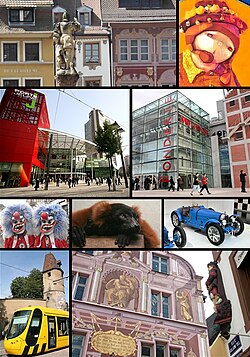Mulhouse | |
|---|---|
Subprefecture and commune | |
 | |
| Coordinates: 47°45′N7°20′E / 47.75°N 7.34°E | |
| Country | France |
| Region | Grand Est |
| Department | Haut-Rhin |
| Arrondissement | Mulhouse |
| Canton | Mulhouse-1, 2 and 3 |
| Intercommunality | Mulhouse Alsace Agglomération |
| Government | |
| • Mayor (2020–2026) | Michèle Lutz [1] (LR) |
Area 1 | 22.18 km2 (8.56 sq mi) |
| • Urban | 239.1 km2 (92.3 sq mi) |
| Population (2022) [2] | 104,924 |
| • Density | 4,700/km2 (12,000/sq mi) |
| • Urban | 246,692 Metro 6,394,037 Oberrhein |
| Time zone | UTC+01:00 (CET) |
| • Summer (DST) | UTC+02:00 (CEST) |
| INSEE/Postal code | 68224 /68100, 68200 |
| Dialling codes | 0389, 0369 |
| Elevation | 232–338 m (761–1,109 ft) (avg. 240 m or 790 ft) |
| Website | www |
| 1 French Land Register data, which excludes lakes, ponds, glaciers > 1 km2 (0.386 sq mi or 247 acres) and river estuaries. | |
Mulhouse ( /məˈluːz/ ; [4] French: [myluz] ⓘ ; Alsatian: Mìlhüsa [mɪlˈhyːsa] ; German: Mülhausen [myːlˈhaʊzn̩] ⓘ , meaning "mill house") is a French city of the European Collectivity of Alsace (Haut-Rhin department, in the Grand Est region of France). It is near the border with Switzerland and Germany. It is the largest city in Haut-Rhin and second largest in Alsace after Strasbourg.
Contents
- Administration
- History
- 2025 Mulhouse stabbing attack
- Geography
- Districts
- Climate
- Population
- Main sights
- Principal economic activities
- Education
- Transport
- Air
- Rail
- Urban transport
- Road
- Sports
- People
- Twin towns—sister cities
- See also
- References
- Bibliography
- External links
Mulhouse is known for its museums, especially the Cité de l'Automobile (also known as the Musée national de l'automobile, 'National Museum of the Automobile') and the Cité du Train (also known as Musée Français du Chemin de Fer, 'French Museum of the Railway'), respectively the largest automobile and railway museums in the world.[ citation needed ] An industrial town nicknamed "the French Manchester", [5] Mulhouse is also the main seat of the Upper Alsace University, where the secretariat of the European Physical Society is found.















